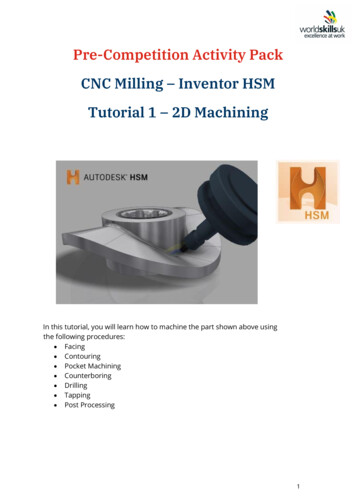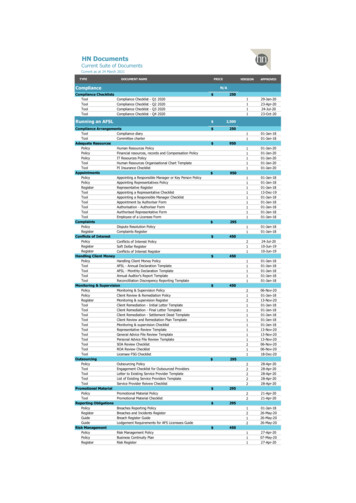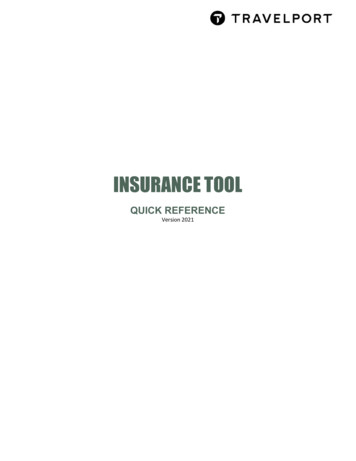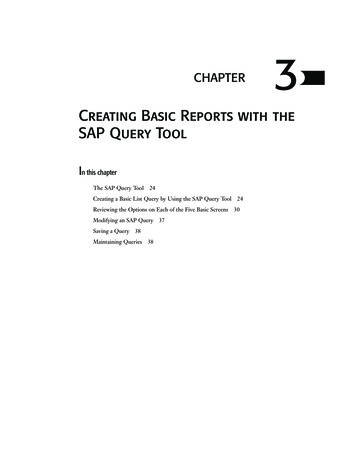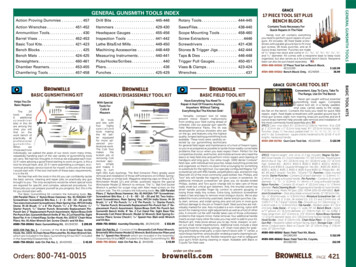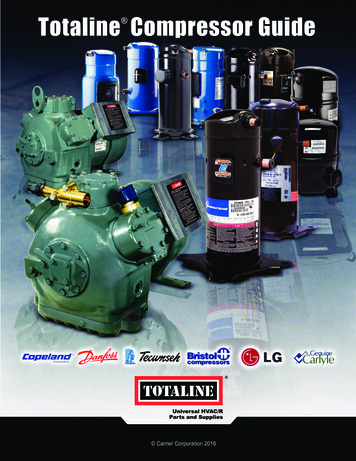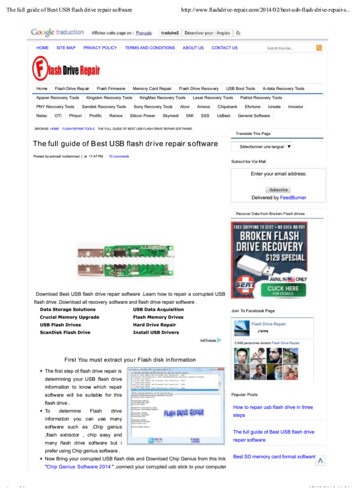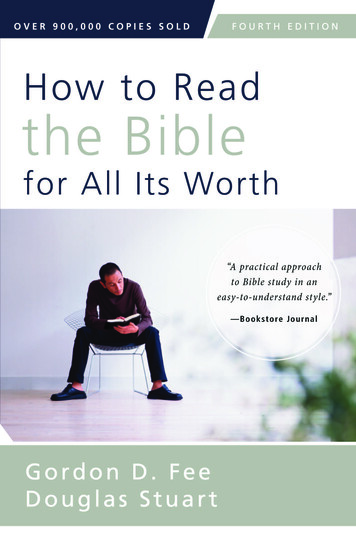
Transcription
The Basic Tool: A Good Translation45Or should one translate it “lamp,” and let readers bridge the gapfor themselves? Should “holy kiss” be translated “the handshakeof Christian love” in cultures where public kissing is offensive?Should “coals of fire” become “burning embers/coals,” since thisis more normal English? Should “endurance inspired by hope”(1 Thess 1:3), a formal equivalent that is almost meaningless inEnglish, be rendered “your endurance inspired by hope,” which iswhat Paul’s Greek actually means?Translators are not always consistent, but one of these theorieswill govern all translators’ basic approach to their task. At timesthe free or literal translations can be excessive, so much so thatClarence Jordan in his Cotton Patch Version “translated” Paul’sletter to Rome as to Washington (!), while Robert Young, in aliteral rendering published in 1862, transformed one Pauline sentence into this impossible English (?): “Whoredom is actually heardof among you, and such whoredom as is not even named amongthe nations — as that one hath the wife of the father” (1 Cor 5:1).This is not a valid translation at all.The several translations of the whole Bible that are most easilyaccessible may be placed on a formal or functional equivalent andhistorical distance scale, as shown on the following graph (line 1represents the original translations, line 2 their various revisions;note that in the case of the RSV, both the NRSV and ESV movemore toward the middle, as does the NIV2 (2011), while the NJB,REB and NLT [the revision of the Living Bible] also have movedmore toward the middle from their originals).Formal Equivalence(literal)Functional Equivalence(dynamic)1. KJVNASBRSVNIV1 NABGNBJB2. NKJVHCSBNRSV NIV2 NJBREBNLTFreeNEBLBThe MessageESVOur view is that the best theory of translation is the one thatremains as faithful as possible to both the original and receptorlanguages, but that when something has to “give,” it should be infavor of the receptor language — without losing the meaning of theoriginal language, of course — since the very reason for translationis to make these ancient texts accessible to the English-speakingperson who does not know the original languages.9780310517825 HowReadBible AllWorth 4ed int CS6.indd 453/19/14 9:45 AM
The Gospels: One Story, Many Dimensions143of Jesus on the “desolating sacrilege” appears when read in parallel columns:Matthew 24:15 – 16Mark 13:14Luke 21:20 – 21So when you seeBut when you seeWhen you seeJerusalem surrounded byarmies, then know thatthe desolatingthe desolatingits desolation has comenear.sacrilege standing inthe holy place, aswas spoken by theprophet Danielsacrilege set up whereit ought not to be(let the readerunderstand),(let the readerunderstand),thenthenThenthose in Judeamust fleethose in Judeamust fleethose in Judeamust fleeto the mountains;to the mountains;to the mountains, andIt should be noted first of all that this saying is in the OlivetDiscourse in exactly the same sequence in all three gospels.When Mark recorded these words, he was calling his readers toa thoughtful reflection as to what Jesus meant by “the desolatingsacrilege set up where it ought not to be.” Matthew, also inspiredby the Spirit, helped his readers by making the saying a little moreexplicit. The “desolating sacrilege,” he reminds them, was spokenabout by Daniel, and what Jesus meant by “where it ought not tobe” was “the holy place” (the temple in Jerusalem). Luke, equallyinspired of the Spirit, simply interpreted the whole saying for thesake of his Gentile readers. He really lets them understand! WhatJesus meant by all this was, “When you see Jerusalem surroundedby armies, then know that its desolation has come near.”Thus one can see how thinking horizontally and knowing thatMatthew and Luke used Mark can help you to interpret any one ofthe gospels as you read it. Similarly, awareness of gospel parallelsalso helps you to see how the same materials sometimes came tobe used in new contexts in the ongoing church.Take, for another example, Jesus’ lament over Jerusalem, whichis one of those sayings Matthew and Luke have in common that9780310517825 HowReadBible AllWorth 4ed int CS6.indd 1433/19/14 9:45 AM
The Gospels: One Story, Many Dimensions151First of all, you should know that the basic theological framework of the entire New Testament is eschatological. Eschatologyhas to do with the end, when God brings this age to its close. MostJews in Jesus’ day were eschatological in their thinking. That is,they thought they lived at the very brink of time, when God wouldstep into history and bring an end to this age and usher in the ageto come. The Greek word for the “end” they were looking for iseschatos. Thus to be eschatological in one’s thinking meant to belooking for the end.The Jewish Eschatological HopeThe EschatonThis Age(Satan’s Time)The Age to Come(The Time of God’s Rule)characterized by:sinsicknessdemon-possessionevil people triumphcharacterized by:the presence of the SpiritrighteousnesshealthpeaceThe earliest Christians, of course, well understood this eschatological way of looking at life. For them the events of Jesus’ coming, his death and resurrection, and his giving of the Spirit wereall related to their expectations about the coming of the end. Ithappened like this.The coming of the end also meant for them a new beginning —the beginning of God’s new age, the messianic age. The new agewas also referred to as the kingdom of God, which meant “thetime of God’s rule.” This new age would be a time of righteousness (e.g., Isa 11:4 – 5), and people would live in peace (e.g.,Isa 2:2 – 4). It would be a time of the fullness of the Spirit (Joel2:28 – 30) when the new covenant spoken of by Jeremiah wouldbe realized (Jer 31:31 – 34; 32:38 – 40). Sin and sickness wouldbe done away with (e.g., Zech 13:1; Isa 53:5). Even the material creation would feel the joyful effects of this new age (e.g., Isa11:6 – 9).Thus when John the Baptist announced the coming of the endto be very near and baptized God’s Messiah, eschatological fervorreached fever pitch. The Messiah was at hand, the one who wouldusher in the new age of the Spirit (Luke 3:7 – 17).9780310517825 HowReadBible AllWorth 4ed int CS6.indd 1513/19/14 9:45 AM
The Gospels: One Story, Many Dimensions153still had to live out these benefits and values in the present world.Thus the essential theological framework for understanding theNew Testament looks like this:The New Testament Eschatological ViewThe EschatonTHIS AGEbegun(Passing away)consummatedTHE AGE TO COMEThe Cross andResurrectionAlreadyrighteousness . . . . . . . .peace . . . . . . . . . . . . . .health . . . . . . . . . . . . .Spirit . . . . . . . . . . . . . .(never ending)TheSecond ComingNot Yetcompleted righteousnessfull peaceno sickness or deathin complete fullnessThe hermeneutical key to much in the New Testament, andespecially to the ministry and teaching of Jesus, is to be found inthis kind of “tension.” Precisely because the kingdom, the time ofGod’s rule, has been inaugurated with Jesus’ own coming, we arecalled to life in the kingdom, which means life under his lordship,freely accepted and forgiven but committed to the ethics of thenew era and to seeing them worked out in our own lives and worldin this present age.Thus when we pray, “Your kingdom come,” we pray first ofall for the consummation. But because the kingdom — the time ofGod’s rule — that we long to see consummated has already begun,the same prayer is full of implications for the present. And, ofcourse, by implication this means that by the Spirit we are now tolive out the life and values of the “age to come” that has alreadybeen set in motion through the resurrection.9780310517825 HowReadBible AllWorth 4ed int CS6.indd 1533/19/14 9:45 AM
208How to Read the Bible for All Its WorthProphetic Perspective of Chronological EventsStraight-On viewSide viewThus there are some descriptions in the Prophetic Books that maybelong to the final events of the age (e.g., Joel 3:1 – 3; Zeph 3:8 – 9;Zech 14:9). But the temporal judgments that are often spoken ofin conjunction with these final events must not be pushed into thefuture as well.One further point should be mentioned. Eschatological language by its very nature is often metaphorical. Sometimes thesemetaphors express poetically the language of the final events butare not necessarily intended to be predictions of those events perse. An example is found in the well-known “dry bones” oraclein Ezekiel (37:1 – 14). Using the language of the resurrection ofthe dead, an event we know will occur at the end of the age, Godpredicts through Ezekiel the return of the nation of Israel fromthe exile in Babylon in the sixth century BC (vv. 12 – 14). Thusan event that to us is past (as described in Ezra 1 – 2) is predictedmetaphorically with eschatological language as though it were anend-time event.A Concern: Prophecy and Second MeaningsAt a number of places in the New Testament, reference is madeto Old Testament passages that do not appear to refer to what theNew Testament writers seem to suggest they do. That is, these passages seem to have a clear meaning in their original Old Testamentsetting and yet are used in connection with a different meaning bya New Testament writer.As an example, consider the two stories of how Moses andthe Israelites were miraculously given water from rocks in thewilderness — once at Rephidim (Exod 17:1 – 7) and once at Kadesh(Num 20:1 – 13). The stories are, it appears, simple enough and9780310517825 HowReadBible AllWorth 4ed int CS6.indd 2083/19/14 9:45 AM
Appendix:The Evaluation andUse of CommentariesThroughout this book we have regularly suggested that thereare times when you will want to consult a good commentary.We do not apologize for this. A good commentary is everybit as much a gift to the church as are good sermons, good video,audio and web resources, or good counselors.Our purpose in this appendix is simple. After some words onhow you may go about evaluating a commentary as to its exegetical value, we will list one or more of the better commentariesfor each of the biblical books. There is an inherent problem insuch a list, of course, in that excellent commentaries are regularlyappearing. We are listing what is available as of our writing. As newcommentaries come out, you can evaluate them according to theprocedures given here.THE EVALUATION OF COMMENTARIESIf you are a serious Bible student, you will eventually want tosecure or have access to a good commentary for each book ofthe Bible. There really is no completely satisfactory one-volumecommentary. One-volume commentaries are usually designed todo the very work we have tried to teach you to do on your ownthroughout this book. They briefly give the historical context andthen trace the meaning of the text in terms of its literary context.This indeed has its value, but much of this you can find in the2759780310517825 HowReadBible AllWorth 4ed int CS6.indd 2753/19/14 9:45 AM
276How to Read the Bible for All Its WorthZondervan Handbook to the Bible, for example. What you want acommentary for is basically to supply three things: (1) helps onsources and information about the historical context, (2) answersto those manifold content questions, and (3) thorough discussionsof difficult texts as to the possibilities of meaning, along with supporting arguments.How, then, does one evaluate a commentary? First, you donot evaluate on the basis of your agreement with the author. Ifthe commentary is really a good one, and if you have done yourown exegesis well, more often than not you and the better commentaries will be in agreement. But agreement is not the basiccriterion.Moreover, you do not evaluate on the basis of its “turningyou on.” The point of a commentary is exegesis — what the textmeans — not homiletics — preaching the text in our day. You maymake good use of books of this kind in trying to discover how touse a text in the present scene. As preachers, we ourselves confessto the usefulness of such books to get one’s mind to thinkingabout the present age. But these are not commentaries, even if theyare excellent models for how to apply the Bible in the here andnow. Our concern here is not with these books but with exegeticalcommentaries alone.There are at least seven criteria you should use in judging acommentary. Not all of these are of the same kind, nor are all ofthem of equal importance. But all of these combine to help atthe one crucial point: Does this commentary help you understandwhat the biblical text actually said?The first two criteria are basically points of information thatyou will want to know about the commentary.1. Is the commentary exegetical, homiletical, or a combination of both? This simply reiterates what we have just said above.Remember, what you really want in a commentary is exegesis. Ifit also has hermeneutical suggestions, you may find this helpful,but what you want are answers to your content questions — andcontent questions are primarily exegetical.2. Is it based on the Greek or Hebrew text, or on an Englishtranslation? It is not bad for a commentary to be based on atranslation, as long as the author knows the text in the original language and uses this knowledge as the real source of their comments.Note well: You can use most commentaries based on the Greek9780310517825 HowReadBible AllWorth 4ed int CS6.indd 2763/19/14 9:45 AM
Appendix: The Evaluation and Use of Commentaries277or Hebrew text. Sometimes you will have to “read around” theGreek or Hebrew, but you can usually do this with minimal loss.The next criterion is the MOST IMPORTANT, and it is thereal place to bring your evaluation.3. When a text has more than one possible meaning, doesthe author discuss all the possible meanings, evaluate them, andgive reasons for his or her own choice? For example, in chapter 2we gave an illustration from 1 Corinthians 7:36 for which thereare at least three possible meanings. A commentary does notfully inform you unless the author discusses all three possibilities, gives reasons for and against each, then explains his or herown choice.The next four criteria are important if you are going to get allthe help you need.4. Does the author discuss text-critical problems? You havealready learned the importance of this in chapter 2.5. Does the author discuss the historical background of theidea of the text at important places?6. Does the author give bibliographic information so you cando further study if you wish?7. Does the introduction section in the commentary give youenough information about the historical context to enable you tounderstand the occasion of the book?The best way to get at all this is simply to pick one of thereally difficult texts in a given biblical book and see how helpfula commentary is in giving information and answering questions,and especially how well it discusses all possible meanings. One caninitially evaluate the worth of a commentary on 1 Corinthians,for example, by seeing how the author discusses 7:36 or 11:10.For the Pastoral Epistles, check 1 Timothy 2:15. For the bookof Genesis, 2:17 would constitute a “checkpoint.” For Isaiah, itmight be 7:14 – 17. And so on.The final judgment, of course, is how well the author puts hisor her information together in understanding the text in its context. Some commentaries that are mines of historical and bibliographic data are unfortunately not always adept at explaining thebiblical writer’s meaning in context.Before we give our lists, let us repeat: You do not begin yourBible study with a commentary! You go to the commentary afteryou have done your own work. The reason you eventually consult9780310517825 HowReadBible AllWorth 4ed int CS6.indd 2773/19/14 9:45 AM
278How to Read the Bible for All Its Wortha commentary is to find answers to the content questions that havearisen in your own study. At the same time, of course, the commentary will alert you to questions you failed to ask but perhapsshould have.Please be warned that the commentaries we list here do notalways represent theological viewpoints with which we agree. Weare not recommending their conclusions but rather their alertnessto the kinds of issues we have mentioned above. Use them withcare and caution. We have recommended evangelical commentaries only when in our opinion they were clearly the most exegetically useful for you.OLD TESTAMENT COMMENTARIESThere are several complete and up-to-date Old Testament commentary series that meet the criteria we have described andare evangelical in theological outlook: The Expositor’s BibleCommentary (7 vols., Grand Rapids, MI: Zondervan); theTyndale Old Testament Commentaries (28 vols., Downers Grove,IL: InterVarsity Press); the New American Commentary (28 vols.,Nashville, TN: Broadman & Holman); and the Word BiblicalCommentary (34 vols., Grand Rapids, MI: Zondervan). The latter contains among its volumes a mixture of evangelical and nonevangelical commentaries, and each must therefore be evaluatedon its own merits. A three-volume series on the Minor Prophets(The Minor Prophets, Grand Rapids, MI: Baker) is also available.The century-old Keil and Delitzsch (K-D) remains one of the bestcomplete series you can purchase for the Old Testament. TheTyndale Old Testament Commentaries, a series that continues tobe revised and updated, represent perhaps the best starter set ofcommentaries anyone could purchase.Other commendable series are also underway, mostly butnot entirely complete. They include: The New InternationalCommentary on the Old Testament (Grand Rapids, MI:Eerdmans), The NIV Application Commentary series (GrandRapids, MI: Zondervan), and the Understanding the BibleCommentary Series: Old Testament (16 vols., Grand Rapids, MI:Baker). As individual volumes in these series are published, lookthem over. When any of the series becomes complete, considerbuying it, whether in book or in electronic form.9780310517825 HowReadBible AllWorth 4ed int CS6.indd 2783/19/14 9:45 AM
Appendix: The Evaluation and Use of Commentaries279GenesisFor the general reader: James McKeown, Genesis (TwoHorizons Old Testament Commentary Series); GrandRapids, MI: Eerdmans, 2008.For the advanced student: Kenneth A. Matthews, Genesis(NAC), 2 vols.; Nashville, TN: Broadman & Holman,1996, 2005; Bruce K. Waltke, Genesis: A Commentary;Grand Rapids, MI: Zondervan, 2001; Gordon Wenham,Genesis (WBC), 2 vols.; Dallas, TX: Word, 1987, 1994.ExodusFor the general reader: Peter Enns, Exodus (NIVAC); GrandRapids, MI: Zondervan, 2000; Walter Kaiser Jr., Exodus(EBC); Grand Rapids, MI: Zondervan, 1992.For the advanced student: Douglas Stuart, Exodus (NAC);Nashville, TN: Broadman and Holman, 2006.LeviticusFor the general reader: Mark F. Rooker, Leviticus (NAC);Nashville, TN: Broadman & Holman, 2000; Allen Ross,Holiness to the Lord: A Guide to the Exposition of the Book ofLeviticus; Grand Rapids, MI: Baker, 2006.For the advanced student: Gordon Wenham, The Book ofLeviticus (NICOT); Grand Rapids, MI: Eerdmans, 1994.NumbersFor the general reader: David Stubbs, Numbers (BrazosTheological Commentary on the Bible); Grand Rapids, MI:Brazos Press, 2009; Gordon Wenham, Numbers (TOTC);Downers Grove, IL: IVP Academic, 2008.For the advanced student: Timothy R. Ashley, The Bookof Numbers (NICOT); Grand Rapids, MI: Eerdmans,1993; R. Dennis Cole, Numbers (NAC); Nashville, TN:Broadman & Holman, 2000.DeuteronomyFor the general reader: Daniel Block, Deuteronomy (NIVAC);Grand Rapids, MI: Zondervan, 2012.For the advanced student: Duane Christensen, Deuteronomy(WBC), rev. ed., 2 vols.; Nashville, TN: Nelson, 2001, 2002;9780310517825 HowReadBible AllWorth 4ed int CS6.indd 2793/19/14 9:45 AM
How to Read the Bible for All Its Worth280Peter Craigie, The Book of Deuteronomy (NICOT); GrandRapids, MI: Eerdmans, 1976; Eugene H. Merrill, Deuteronomy(NAC); Nashville, TN: Broadman & Holman, 1994.JoshuaFor the general reader: Richard Hess, Joshua (TOTC);Downers Grove, IL: IVP Academic, 2008.For the advanced student: David M. Howard Jr., Joshua(NAC); Nashville, TN: Broadman & Holman, 1998.JudgesFor the general reader: K. Lawson Younger, Judges (NIVAC);Grand Rapids, MI: Zondervan, 2002.For the advanced student: Daniel I. Block, Judges, Ruth (NAC);Nashville, TN: Broadman & Holman, 1999; Barry Webb,Judges (NICOT); Grand Rapids, MI: Eerdmans, 2012.RuthFor the general reader: Iain Duguid, Esther & Ruth (REC);Phillipsburg, NJ: P & R Publishing, 2005.For the advanced student: Daniel I. Block, Judges, Ruth (NAC);Nashville, TN: Broadman & Holman, 1999; Robert ChisholmJr., A Commentary on Judges and Ruth; Grand Rapids, MI:Kregel Academic, 2013; Robert L. Hubbard Jr., The Book ofRuth (NICOT); Grand Rapids, MI: Eerdmans, 1988.1, 2 Sam uelFor the general reader: Bill T. Arnold, 1 & 2 Samuel (NIVAC);Grand Rapids, MI: Zondervan, 2003; Joyce Baldwin, 1 and2 Samuel (TOTC); Downers Grove, IL: InterVarsity Press,1988.For the advanced student: Robert Bergen, 1, 2 Samuel (NAC);Nashville, TN: Broadman & Holman, 1996; Robert P.Gordon, 1 and 2 Samuel; Grand Rapids, MI: Zondervan,1986; David Tsumura, The First Book of Samuel (NICOT);Downers Grove, IL: IVP Academic, 2007.1, 2 KingsFor the general reader: Iain Provan, 1 & 2 Kings (UBCS);Grand Rapids, MI: Baker, 1993; Donald J. Wiseman, 1 and2 Kings (TOTC); Downers Grove, IL: InterVarsity, 1993.9780310517825 HowReadBible AllWorth 4ed int CS6.indd 2803/19/14 9:45 AM
Appendix: The Evaluation and Use of Commentaries281For the advanced student: Paul House, 1, 2 Kings (NAC);Nashville,, TN: Broadman & Holman, 1995.1, 2 Chron iclesFor the general reader: Andrew Hill, 1 & 2 Chronicles(NIVAC); Grand Rapids, MI: Zondervan, 2008.For the advanced student: Raymond Dillard, 2 Chronicles(WBC); Dallas, TX: Word, 1988; Richard Pratt, 1 &2 Chronicles; Fearn, UK: Mentor, 1999; J. A. Thompson,1, 2 Chronicles (NAC); Nashville, TN: Broadman &Holman, 1994.Ezra – NehemiahFor the general reader: Derek Kidner, Ezra & Nehemiah(TOTC); Downers Grove, IL: IVP Academic, 2009; GaryV. Smith, Ezra, Nehemiah, Esther (Cornerstone BiblicalCommentary); Carol Stream, IL: Tyndale House, 2010.For the advanced student: Mervin Breneman, Ezra, Nehemiah,Esther (NAC); Nashville, TN: Broadman & Holman, 1993;H. G. M. Williamson, Ezra – Nehemiah (WBC); Dallas, TX:Word, 1985.EstherFor the general reader: Debra Reid, Esther (TOTC); DownersGrove, IL; IVP Academic, 2008.For the advanced student: Frederic W. Bush, Ruth, Esther(WBC); Dallas, TX: Word, 1996.JobFor the general reader: Francis Anderson, Job (TOTC);Downers Grove, IL: IVP Academic, 2008.For the advanced student: John E. Hartley, The Book of Job(NICOT); Grand Rapids, MI: Eerdmans, 1988; ElmerSmick, Job (EBC); Grand Rapids, MI: Zondervan, 1988.PsalmsFor the general reader: Craig C. Broyles, Psalms (UBCS);Peabody, MA: Hendrickson, 1999.For the advanced student: Peter Craigie and Marvin Tate,Psalms 1 – 50; Marvin Tate, Psalms 51 – 100; Leslie Allen,9780310517825 HowReadBible AllWorth 4ed int CS6.indd 2813/19/14 9:45 AM
How to Read the Bible for All Its Worth282Psalms 101 – 150 (WBC); Dallas, TX: Word, 2004, 1991,2002 respectively; Willem VanGemeren, Psalms (EBC), rev.ed.; Grand Rapids, MI: Zondervan, 2008; Bruce Waltkeand James Houston, The Psalms as Christian Worship;Grand Rapids, MI: Eerdmans, 2010.ProverbsFor the general reader: David A. Hubbard, Proverbs (Masteringthe Old Testament); Dallas, TX: Word, 1989; TremperLongman III, Proverbs (BCOT); Grand Rapids, MI: Baker,2006.For the advanced student: Duane A. Garrett, Proverbs,Ecclesiastes, Song of Songs (NAC); Nashville, TN: Broadman& Holman, 1993; Bruce Waltke, The Book of Proverbs(NICOT), 2 vols.; Grand Rapids, MI: Eerdmans, 2004,2005.EcclesiastesFor the general reader: Iain Provan, Ecclesiastes/Song of Songs(NIVAC); Grand Rapids, MI: Zondervan, 2001.For the advanced student: Craig Bartholomew, Ecclesiastes(BCOT); Grand Rapids, MI: Baker, 2009; Duane A.Garrett, Proverbs, Ecclesiastes, Song of Songs (NAC);Nashville, TN: Broadman & Holman, 1993; TremperLongman III, The Book of Ecclesiastes (NICOT); GrandRapids, MI: Eerdmans, 1998.Song of SongsFor the general reader: G. Lloyd Carr, The Song of Solomon(TOTC); Downers Grove, IL: InterVarsity Press, 1984.For the advanced student: Duane Garrett and Paul House, Songof Songs/Lamentations (WBC); Nashville, TN: ThomasNelson, 2004; Tremper Longman III, Song of Songs(NICOT); Grand Rapids, MI: Eerdmans, 2001.IsaiahFor the general reader: Alec Motyer, The Prophecy of Isaiah;Downers Grove, IL: InterVarsity Press, 1993.For the advanced student: John Oswalt, The Book of Isaiah(NICOT), 2 vols.; Grand Rapids, MI: Eerdmans, 1981,9780310517825 HowReadBible AllWorth 4ed int CS6.indd 2823/19/14 9:45 AM
Appendix: The Evaluation and Use of Commentaries2831998; Gary Smith, Isaiah (NAC), 2 vols.; Nashville, TN:Broadman & Holman, 2007, 2009.JeremiahFor the general reader: Derek Kidner, The Message of Jeremiah(BST); Downers Grove, IL: IVP Academic, 2004.For the advanced student: Leslie Allen, Jeremiah (OTL);Louisville, KY: Westminster John Knox, 2008; John A.Thompson, The Book of Jeremiah (NICOT); Grand Rapids,MI: Eerdmans, 1995.LamentationsFor the general reader: Robin Parry, Lamentations (Two HorizonsCommentary); Grand Rapids, MI: Eerdmans, 2010.For the advanced student: Delbert R. Hillers, Lamentations(AB); New York, NY: Doubleday, 1992; F. B. Huey Jr.,Jeremiah, Lamentations (NAC); Nashville, TN: Broadman& Holman, 1993.EzekielFor the general reader: Douglas Stuart, Ezekiel (The Preacher’sCommentary); Nashville, TN: Thomas Nelson, 2002.For the advanced student: Daniel I. Block, Ezekiel (NICOT) 2vols.; Grand Rapids, MI: Eerdmans, 1997, 1998; MargaretOdell, Ezekiel (Smyth & Helwys Bible Commentary);Macon, GA: Smyth & Helwys, 2005.DanielFor the general reader: Iain Duguid, Daniel (REC);Phillipsburg, NJ: P & R Publishing, 2008.For the advanced student: Stephen R. Miller, Daniel (NAC);Nashville, TN: Broadman & Holman, 1994; AndrewSteinmann, Daniel (CC); St. Louis, MO: ConcordiaPublishing House, 2008.HoseaFor the general reader: Derek Kidner, The Message of Hosea(BST); Downers Grove, IL: IVP Academic, 2004.For the advanced student: Duane A. Garrett, Hosea, Joel (NAC);Nashville, TN: Broadman & Holman, 1996; DouglasStuart, Hosea – Jonah (WBC); Dallas, TX: Word, 1987.9780310517825 HowReadBible AllWorth 4ed int CS6.indd 2833/19/14 9:45 AM
284How to Read the Bible for All Its WorthAmosFor the general reader: Gary Smith, Hosea, Amos, Micah(NIVAC); Grand Rapids, MI: Zondervan, 2001.For the advanced student: Francis Anderson and David NoelFreedman, Amos (AB); New Haven, CT: Yale UniversityPress, 1989; R. Reed Lessing, Amos (CC); St. Louis, MO:Concordia, 2009; Jeffrey Niehaus, Amos (The MinorProphets); Grand Rapids, MI: Baker, 1992.ObadiahFor the general reader: David Baker, Obadiah, Jonah, Micah(TOTC); Downers Grove, IL: InterVarsity Press, 1988.For the advanced student: Jeffrey Niehaus, Obadiah (TheMinor Prophets); Grand Rapids, MI: Baker, 1992; PaulRaabe, Obadiah (AB); New Haven, CT: Yale UniversityPress, 1996; Douglas Stuart, Hosea – Jonah (WBC); Dallas,TX: Word, 1987.JonahFor the general reader: T. Desmond Alexander, Obadiah,Jonah, Micah (TOTC); Downers Grove, IL: IVP Academic,2009; Joyce Baldwin, Jonah (The Minor Prophets); GrandRapids, MI: Baker, 1993.For the advanced reader: Douglas Stuart, Hosea – Jonah (WBC);Dallas, TX: Word, 1987.MicahFor the general reader: Dale Ralph Davis, Micah (EP StudyCommentary); Darlington, UK: Evangelical Press, 2010.For the advanced student: Kenneth L. Barker, Micah (NAC);Nashville, TN: Broadman & Holman, 1999; Bruce Waltke,A Commentary on Micah; Grand Rapids, MI: Eerdmans,2008.NahumFor the general reader: David Baker, Nahum, Habakkuk,Zephaniah (TOTC); Downers Grove, IL: IVP Academic,2009.For the advanced student: Waylon Bailey, Nahum (NAC);Nashville, TN: Broadman & Holman, 1999; Tremper9780310517825 HowReadBible AllWorth 4ed int CS6.indd 2843/19/14 9:45 AM
Appendix: The Evaluation and Use of Commentaries285Longman III, Nahum (The Minor Prophets); GrandRapids, MI: Baker, 1993.HabakkukFor the general reader: John Currid, The Expectant Prophet:Habakkuk Simply Explained (Welwyn Commentaries);Darlington, UK: EP Books, 2009.For the advanced student: Carl Armerding, Habakkuk (EBC);Grand Rapids, MI: Zondervan, 1985; F. F. Bruce,Habakkuk (The Minor Prophets); Grand Rapids, MI:Baker, 1993.ZephaniahFor the general reader: David Baker, Nahum, Habakkuk,Zephaniah (TOTC); Downers Grove, IL: InterVarsityPress, 1989.For the advanced student: J. Alec Motyer, Zephaniah (TheMinor Prophets); Grand Rapids, MI: Baker, 1998; RichardPatterson, Nahum, Habakkuk, Zephaniah; Richardson, TX:Biblical Studies Press, 2013.HaggaiFor the general reader: Mark Boda, Haggai, Zechariah(NIVAC); Grand Rapids, MI: Zondervan, 2004.For the advanced student: Eugene Merrill, Haggai, Zechariah,Malachi; Richardson, TX: Biblical Studies Press, 2013;J. Alec Motyer, Haggai (The Minor Prophets); GrandRapids, MI: Baker, 1998.ZechariahFor the general reader: Barry Webb, The Message of Zechariah(BST); Downers Grove, IL: IVP Academic, 2004.For the advanced student: George Klein, Zechariah (NAC);Nashville, TN: Broadman & Holman, 2008; ThomasMcComiskey, Zechariah (The Minor Prophets); GrandRapids, MI: Baker, 1998.MalachiFor the general reader: Iain Duguid, Haggai, Zechariah,Malachi (EP Study Commentary); Darlington, UK:Evangelical Press, 2010.9780310517825 HowReadBible AllWorth 4ed int CS6.indd 2853/19/14 9:45 AM
286How to Read the Bible for All Its WorthFor the advanced student: Ray Clendenen, Zechariah, Malachi(NAC); Nashville, TN: Broadman & Holman, 2004;Douglas Stuart, Malachi (The Minor Prophets); GrandRapids, MI: Baker, 1998; Pieter Verhoef, The Books ofHaggai and Malachi (NICOT); Grand Rapids, MI:Eerdmans, 1994.NEW TESTAMENT COMMENTARIESFor years many people have found help in reading William Barclay’sThe Daily Study Bible (Louisville, KY: Westminster John
208 How to Read the Bible for All Its Worth Prophetic Perspective of Chronological Events Straight-On view Side view Thus there are some descriptions in the Prophetic Books that may belong to the final events of the age (e.g., Joel 3:1 – 3; Zeph 3:8 – 9; Zech 1
